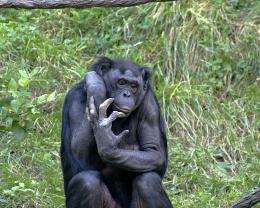May 7, 2010 report
Bonobos say no by shaking their heads

(PhysOrg.com) -- Scientists report having observed and filmed bonobos (also known as pygmy chimpanzees) shaking their heads to say “no” to prevent an unwanted behavior in another animal. Bonobos have never before been observed using the gesture in this way.
The scientists, led by Christel Schneider of the Max Planck Institute for Evolutionary Anthropology in Leipzig, Germany, filmed bonobos (Pan paniscus) in Leipzig Zoo shaking their heads from side to side with disapproval to prevent others doing something, such as a mother stopping her infant from climbing a tree or playing with food instead of eating it.
Bonobos and other great apes such as chimpanzees (Pan troglodytes) have previously been observed using head gestures in their communications. They shake their heads, bow, and nod, but until now shaking their heads from side to side has only been reported as being used to encourage other bonobos to play, and not as a gesture of disapproval. Ms Schneider and colleagues observed the behavior being used by four different bonobos on 13 separate occasions.
Chimpanzees and bonobos are our closest living relatives, and in many human cultures (but not all) shaking the head is also used to signal “no”. Schneider said she believes the behavior in the bonobos may represent an early precursor to negative head-shaking gestures in humans.
Ms Schneider said bonobos are known to use a greater variety of head gestures than chimpanzees, and said the greater sophistication in their communications may have developed because of the type of society bonobos live in, which is egalitarian with complex social structures and a less pronounced hierarchy than in other great ape groups. Shaking their heads to say no could avoid serious conflict.
Bonobos are an endangered species living in remote rainforest areas of the Democratic Republic of the Congo in central Africa. They are the least well-known of the great apes and were only identified in 1933. They stand more erect than the common chimpanzee and often walk bipedally.
The observations were made as part of a wider study of communication in the infants of great apes, including chimpanzees, bonobos, orangutans and gorillas, in several zoos across Europe. The researchers say more research is needed to be certain the gestures really do mean “no”, and to fully document the functions of all the head gestures made by the great apes.
The findings are published in the journal Primates.
More information: Christel Schneider et al., Do bonobos say NO by shaking their head? Primates, DOI:10.1007/s10329-010-0198-2
© 2010 PhysOrg.com














